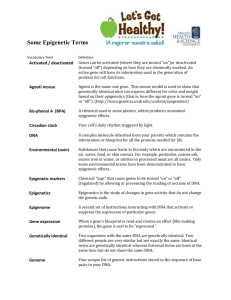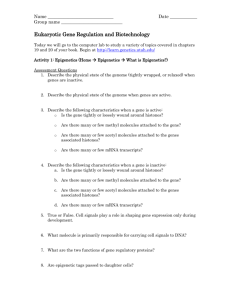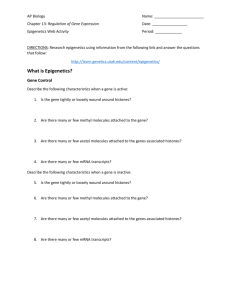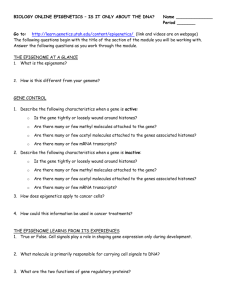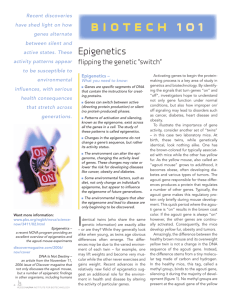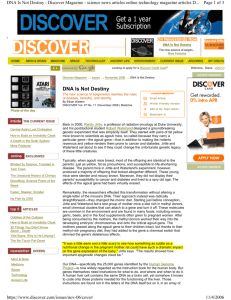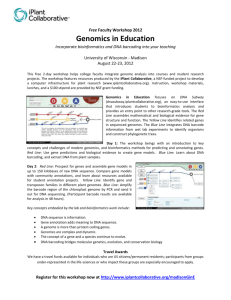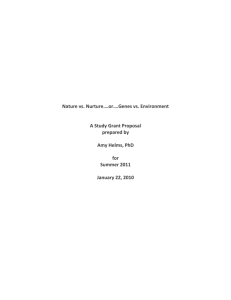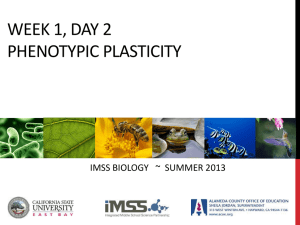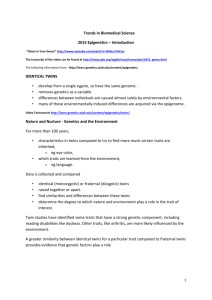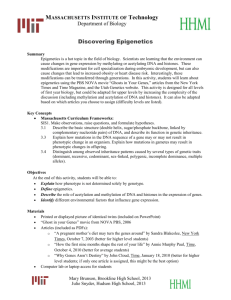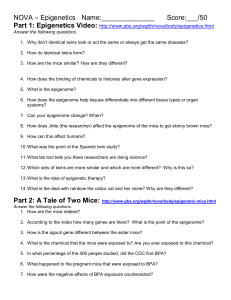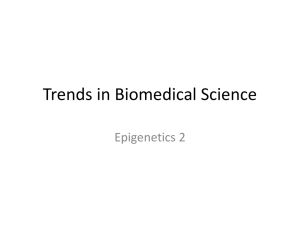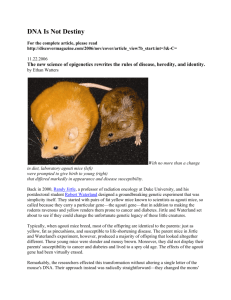File - fiserscience.com
advertisement
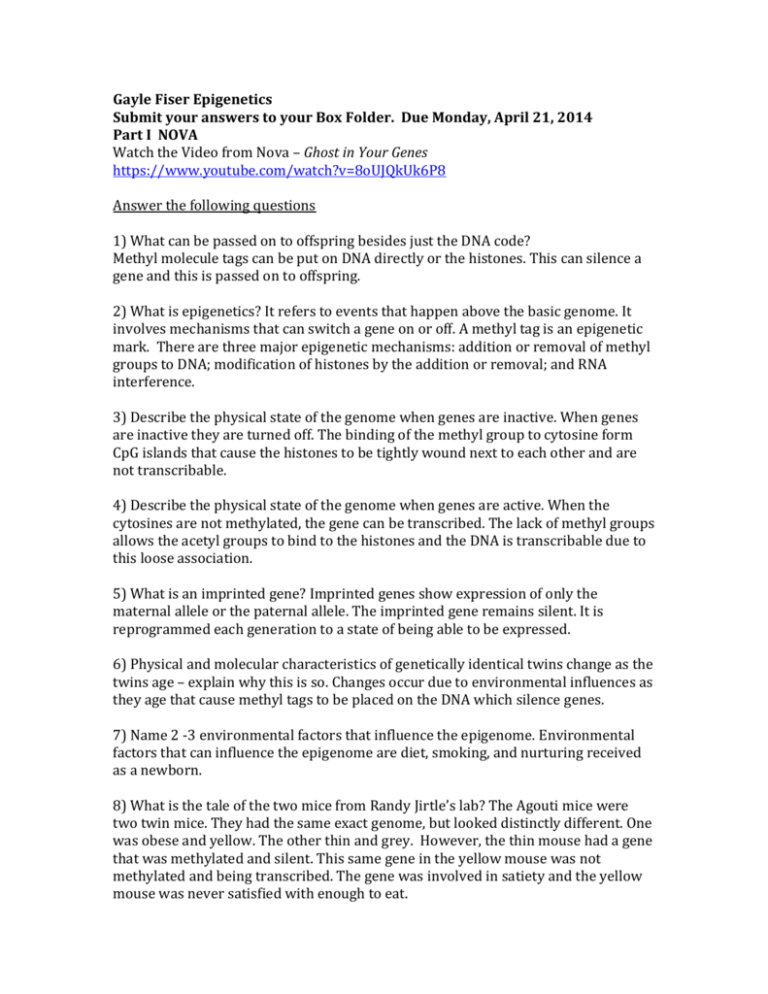
Gayle Fiser Epigenetics Submit your answers to your Box Folder. Due Monday, April 21, 2014 Part I NOVA Watch the Video from Nova – Ghost in Your Genes https://www.youtube.com/watch?v=8oUJQkUk6P8 Answer the following questions 1) What can be passed on to offspring besides just the DNA code? Methyl molecule tags can be put on DNA directly or the histones. This can silence a gene and this is passed on to offspring. 2) What is epigenetics? It refers to events that happen above the basic genome. It involves mechanisms that can switch a gene on or off. A methyl tag is an epigenetic mark. There are three major epigenetic mechanisms: addition or removal of methyl groups to DNA; modification of histones by the addition or removal; and RNA interference. 3) Describe the physical state of the genome when genes are inactive. When genes are inactive they are turned off. The binding of the methyl group to cytosine form CpG islands that cause the histones to be tightly wound next to each other and are not transcribable. 4) Describe the physical state of the genome when genes are active. When the cytosines are not methylated, the gene can be transcribed. The lack of methyl groups allows the acetyl groups to bind to the histones and the DNA is transcribable due to this loose association. 5) What is an imprinted gene? Imprinted genes show expression of only the maternal allele or the paternal allele. The imprinted gene remains silent. It is reprogrammed each generation to a state of being able to be expressed. 6) Physical and molecular characteristics of genetically identical twins change as the twins age – explain why this is so. Changes occur due to environmental influences as they age that cause methyl tags to be placed on the DNA which silence genes. 7) Name 2 -3 environmental factors that influence the epigenome. Environmental factors that can influence the epigenome are diet, smoking, and nurturing received as a newborn. 8) What is the tale of the two mice from Randy Jirtle’s lab? The Agouti mice were two twin mice. They had the same exact genome, but looked distinctly different. One was obese and yellow. The other thin and grey. However, the thin mouse had a gene that was methylated and silent. This same gene in the yellow mouse was not methylated and being transcribed. The gene was involved in satiety and the yellow mouse was never satisfied with enough to eat. 9) What is epigenetic therapy? They are trying treatments that don’t kill the cell, but affect the DNA methylation of the cell. 10) What impact did cycles of famine and harvest have on lifespan in offspring in Overkalix, Sweden? It was specific to whether it was inherited from your grandfather or grandmother. The sensitive period for the famine to occur in the grandfather was around age 10; at the time of sperm formation was occurring. If famine existed for the grandfather when he was around 10, then the grandsons lived longer. However, the sensitive time for the grandmother was while she was still in the womb and eggs were forming. The granddaughter of these women who experienced famine at this time in the womb, died earlier. 11) What age are males sensitive to epigenetic change? What age females? Why? Males are sensitive around age 10, when puberty is beginning with the production of sperm. Females are sensitive while still in the womb as eggs are being formed at this time. Part II Learn Genetics Visit Learn Genetics at University of Utah http://learn.genetics.utah.edu/content/epigenetics/ Complete the following activities: “The Epigenome at a Glance” “Insights from Identical Twins” “Lick Your Rats” “Nutrition and the Epigenome” Answer the following: 1) How does a high nurturing mother shape her pup’s epigenome? A high nurturing mother reduces the amount of methylation of the relaxation gene, making her offspring less stressed. 2) Is there an advantage for being a low nurtured pup? The low nurtured pup is more on-alert. This is beneficial in an environment where food is scare and the environment might be dangerous. 3) How does “royal jelly” make queen bees? The royal jelly is secreted from the glands of the worker bees. A larva destined to be queen would only be fed royal jelly for her lifetime. She will grow ovaries and a larger abdomen and develop queenly behaviors. The royal jelly acts a gene silencer, turning off the “be a worker bee gene”. 4) How do diet influence the epigenome? Food choices cause epigenetic changes. Too little methyl donating folate or choline causes under methylated genes, which don’t turn off genes that should be turned off. Our diets need Folic acid and B vitamins for these methyl groups to be formed. 5) Are you really what you eat? Yes. What you eat can change your gene expression. Part III - Animation Visit the Scientific American Website “Epigenetics Explained” for a visual an epigenetic regulation: http://www.scientificamerican.com/article/epigeneticsexplained/ 1) How would you explain an “epimutation?” An epimutation is a mutation that occurs in the imprinted genes by a change in the DNA sequence or by an epigenetic change. This could happen if there were an undermethylated gene due to lack of proper diet that had a mutation in the gene, but under healthier conditions would not be expressed. Part IV – Nessa Carey “The Epigenetics Revolution.” Read the three articles by Nessa Carey, Natural History; April, May, June 2012; excerpted from her book “The Epigenetics Revolution.” From each of the articles, discuss something that made an impression on you and why. I. “Deconstructing what we took as dogma and rebuilding it….more complex” This statement reminded me of a student conversation. He was puzzled by the use of the word dogma when talking about the central dogma of biology being DNA. He said “I find it hard to understand why they would use the word dogma when talking about something that could change with new discoveries” 2. She made me want to think about what I could do with a Mousetrap game in my classroom to make students think about cascades of events needing to occur in a perfect order. She mentioned DNA methylation tends to stay put, yet histone modifications can be put on, taken off, and put back on. It made the connection with the neuron cell and all of its inactivated genes make sense. 3. “No teeth in your eyeballs” My line is “no eyeballs on your liver”. If we are what our parents ate and their parents ate before them, it will be interesting to see the outcome in future generations. Is this connected to the size of people increasing? Is it more than an overeating environment and perhaps the epigenetics have changed? Also, hormones excreted by women on the contraceptive pill sent me searching for additional information. However, the path looked like a great deal of unreliable sources about Estrogen in the water, which was giving men, prostrate cancer and killing them.
